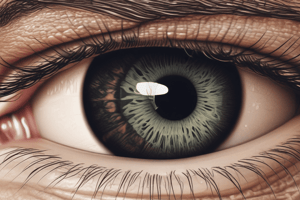Podcast
Questions and Answers
What is the acceptable range of osmolality for an ocular preparation to avoid irritation?
What is the acceptable range of osmolality for an ocular preparation to avoid irritation?
- 100-640 mOsm/kg
- 231-446 mOsm/kg (correct)
- Less than 100 mOsm/kg or greater than 640 mOsm/kg
- Greater than 640 mOsm/kg or less than 231 mOsm/kg
What is the primary purpose of ocular retention in ocular nanosystems?
What is the primary purpose of ocular retention in ocular nanosystems?
- To enhance the irritation consequences of the nanosystem
- To increase the frequency of doses
- To reduce the frequency of doses and improve drug bioavailability (correct)
- To reduce the bioavailability of the drug
What is the primary method used to evaluate the safety of nanoemulsions in terms of irritation consequences?
What is the primary method used to evaluate the safety of nanoemulsions in terms of irritation consequences?
- In vivo tests
- Ex vivo tests
- Visual inspection (correct)
- In vitro tests
What is the primary application of corneal permeation in ocular nanosystems?
What is the primary application of corneal permeation in ocular nanosystems?
What is the reason for the temporary change in osmolality of the ocular preparation after administration?
What is the reason for the temporary change in osmolality of the ocular preparation after administration?
Flashcards are hidden until you start studying
Study Notes
Ocular Anatomy and Drug Delivery
- Conjunctiva, AMD, diabetic retinopathy, and retinoblastoma represent conditions with varying effects on drug absorption, notably less impactful compared to the cornea.
- Certain macromolecular nanomedicines, peptides, and oligonucleotides can penetrate deeply into the eye through conjunctiva.
- Blood-ocular barriers, which include the blood-aqueous barrier (BAB) and blood-retinal barrier (BRB), limit the passage of xenobiotic compounds into the bloodstream.
Ocular Formulations and Administration
- Ocular formulations can be delivered via topical, intraocular, and periocular routes, or through ocular devices.
- Dosage forms include liquid, semi-solid (ointments and gels), solid (powders and inserts), or mixed (in situ gels).
- Most marketed ocular products (over 95%) are in liquid form.
Challenges in Ocular Drug Delivery
- Significant challenges include precorneal, corneal, and blood-corneal barriers that impede effective drug penetration.
- Prolonging drug residence time and ensuring proper ocular permeation have been ongoing scientific pursuits.
Nanotechnology and Ocular Drug Delivery
- Nanotechnology is becoming increasingly appealing for ocular drug delivery due to its ability to encapsulate both hydrophilic and lipophilic drugs.
- Advantages of nanocarriers include enhanced ocular permeability, increased drug stability, sustained residence time, and improved bioavailability.
Characterization Approaches
- Various in vitro, ex vivo, and in vivo characterization techniques help predict the performance of nanocarriers in drug delivery.
- Common in vivo models include rodents (rabbit, rat, mouse), while in vitro models utilize epithelial cells, reconstructed corneas, or excised corneas along with permeation chambers (Franz-type diffusion cell).
Ocular Retention and Bioavailability
- Ocular retention is critical as it minimizes dosing frequency and enhances bioavailability of ophthalmic drugs.
Safety and Irritation Metrics
- Ocular preparations with osmolality lower than 100 mOsm/kg or greater than 640 mOsm/kg are considered irritants.
- The normal range for osmolality in open eyes is between 231 to 446 mOsm/kg, restored shortly (within minutes) after administration of non-isotonic solutions.
Studying That Suits You
Use AI to generate personalized quizzes and flashcards to suit your learning preferences.




